人教版小学六年级数学上册堂堂清全册课 还有练习题
- 格式:pdf
- 大小:11.26 MB
- 文档页数:70
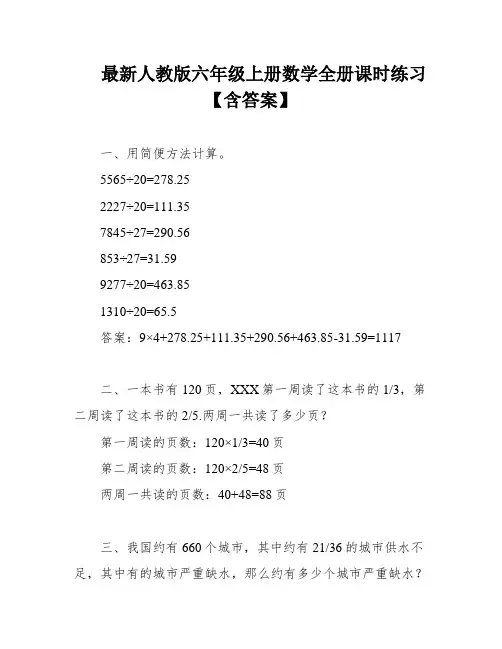
最新人教版六年级上册数学全册课时练习【含答案】一、用简便方法计算。
5565÷20=278.252227÷20=111.357845÷27=290.56853÷27=31.599277÷20=463.851310÷20=65.5答案:9×4+278.25+111.35+290.56+463.85-31.59=1117二、一本书有120页,XXX第一周读了这本书的1/3,第二周读了这本书的2/5.两周一共读了多少页?第一周读的页数:120×1/3=40页第二周读的页数:120×2/5=48页两周一共读的页数:40+48=88页三、我国约有660个城市,其中约有21/36的城市供水不足,其中有的城市严重缺水,那么约有多少个城市严重缺水?21/36的城市供水不足,那么有15/36的城市供水充足。
所以约有15/36的城市不缺水,约有21/36-15/36=6/36的城市供水不足且严重缺水。
即约有1/6的城市严重缺水。
所以约有660×1/6=110个城市严重缺水。
1.用简便方法计算:5565÷20=278.25,2227÷20=111.35,7845÷27=290.56,853÷27=31.59,9277÷20=463.85,1310÷20=65.5.答案为9×4+278.25+111.35+290.56+463.85-31.59=1117.2.XXX在一本有120页的书中,第一周读了1/3,第二周读了2/5.两周一共读了88页。
3.我国大约有660个城市,其中约有21/36的城市供水不足。
约有110个城市严重缺水。
全国大约有多少个城市供水不足?答案:无法确定,文章中没有提供相关数据或信息。
1.228 + 120x = 70(页)的解是多少?答案:无法确定,缺少必要的上下文和信息。
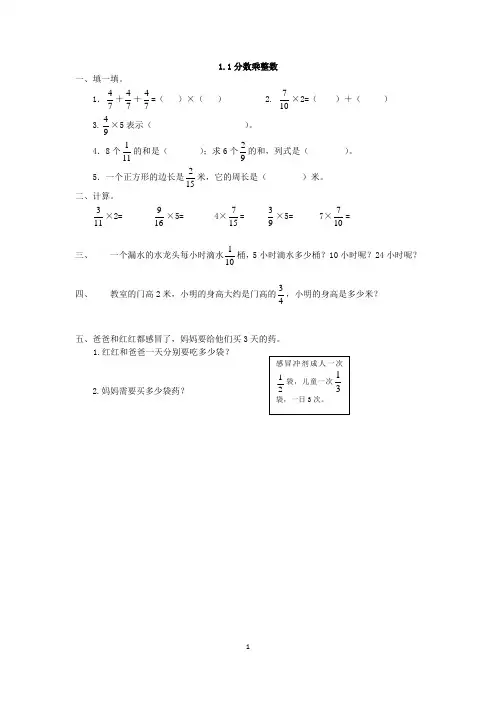
1.1分数乘整数一、填一填。
1.74+74+74=( )×( ) 2. 107×2=( )+( ) 3.94×5表示( )。
4.8个111的和是( );求6个92的和,列式是( )。
5.一个正方形的边长是152米,它的周长是( )米。
二、计算。
113×2= 169×5= 4×157= 93×5= 7×107= 三、 一个漏水的水龙头每小时滴水101桶,5小时滴水多少桶?10小时呢?24小时呢? 四、教室的门高2米,小明的身高大约是门高的43,小明的身高是多少米?五、爸爸和红红都感冒了,妈妈要给他们买3天的药。
1.红红和爸爸一天分别要吃多少袋?2.妈妈需要买多少袋药?答案:一、 1. 3 2.3. 5个 相加4. 6×5.二、三、 ×5=(桶) ×10=1(桶) ×24=(桶)四、2×=(米)五、 1. ×3=1(袋) ×3=(袋)2. 1×3+=7(袋)1.2分数乘分数一、计算。
3241⨯= 31×61= 4131⨯= 3152⨯=14587⨯= 9843⨯= 7921⨯= 7683⨯= 6792⨯= 56245⨯= 二、列式计算。
1.71的51是多少?2.43的65是多少? 3.156千克的31是多少千克? 4.87米的214是多少米?三、校园面积的53是空地,空地的32准备铺草坪,铺草坪的面积占校园总面积的几分之几?四、五(1)班和五(2)班同学在学校操场上打扫卫生,每班负责打扫操场的一半。
五(1)班完成了本班任务的53,五(2)班完成了本班任务的54。
两个班分别打扫了操场的几分之几?答案:一、二、 1. ×=3.4.三、 ×=四、 =1.3 整数乘法运算定律推广到分数一、用简便方法计算。
92×207×9 52×4+52 75×115+116×75(98+274)×27 75×138×107 53×(20-65)二、一本书有120页,小红第一周读了这本书的31,第二周读了这本书的41。
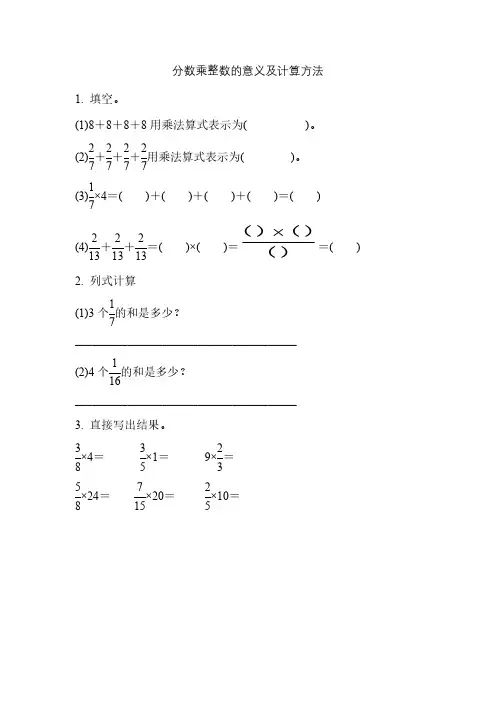
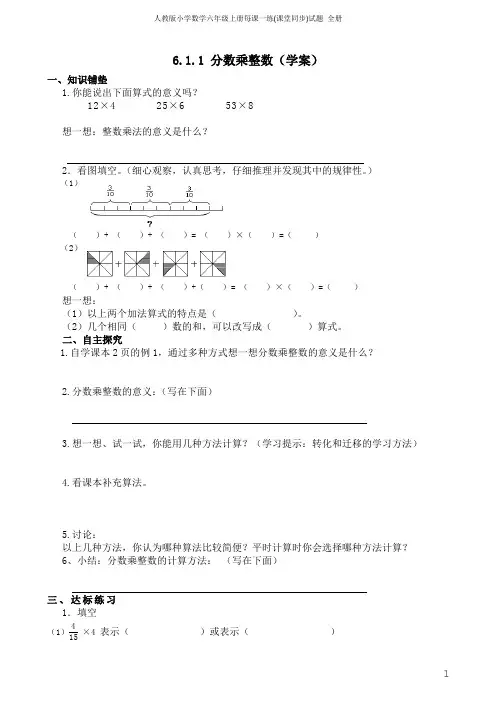
6.1.1 分数乘整数(学案)一、知识铺垫1.你能说出下面算式的意义吗?12×4 25×6 53×8想一想:整数乘法的意义是什么?2.看图填空。
(细心观察,认真思考,仔细推理并发现其中的规律性。
)(1)()+ ()+ ()= ()×()=()(2)()+ ()+ ()+()= ()×()=()想一想:(1)以上两个加法算式的特点是()。
(2)几个相同()数的和,可以改写成()算式。
二、自主探究1.自学课本2页的例1,通过多种方式想一想分数乘整数的意义是什么?2.分数乘整数的意义:(写在下面)3.想一想、试一试,你能用几种方法计算?(学习提示:转化和迁移的学习方法)4.看课本补充算法。
5.讨论:以上几种方法,你认为哪种算法比较简便?平时计算时你会选择哪种方法计算?6、小结:分数乘整数的计算方法:(写在下面)三、达标练习1.填空(1)415×4 表示()或表示()(2)4个15的和是多少?用乘法计算可列式为( )。
2.计算121×4= 59 ×3= 8 ×518 =3.列式计算(1)6个718 相加的和是多少? (2)37的5倍是多少?4.解决问题一辆汽车每分钟行65千米,这辆汽车每小时行驶多少千米?四、拓展练习一根钢管锯成2段需要43分钟,如果锯成9段需要多少分钟?达标测试答案 1.填空(1)415×4 表示(4个415 相加的和是多少)或表示(415的4倍是多少)。
(2)4个15 的和是多少?用乘法计算可列式为(15 ×4=54 )。
2.计算121×4=31 59 ×3=35 8 ×518 = 9203.列式计算(1)6个718 相加的和是多少? (2)37的5倍是多少?718 ×6=3737 ×5=715 4.解决问题一辆汽车每分钟行65千米,这辆汽车每小时行驶多少千米?65×60=72(千米)四、拓展练习 一根钢管锯成2段需要43分钟,如果锯成9段需要多少分钟? 43×(9-1)=43×8=6(分钟)6.1.2 一个数乘分数的意义(学案) 班级 姓名【学习目标】1.结合具体的情境理解一个数乘分数的意义。
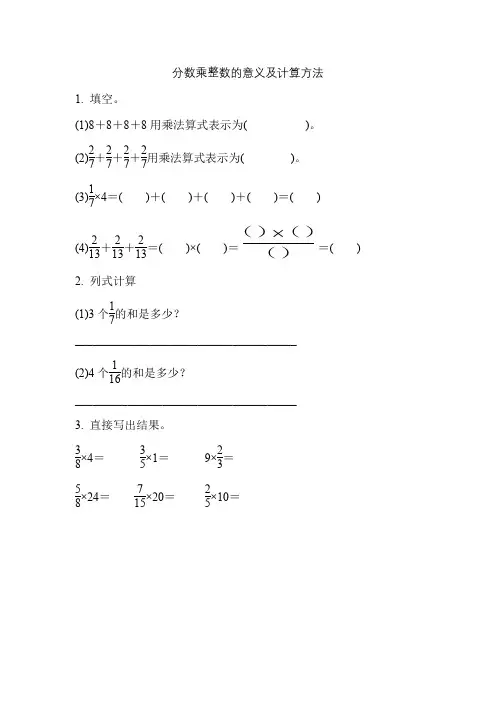
分数乘整数的意义及计算方法1. 填空。
(1)8+8+8+8用乘法算式表示为( )。
(2)27+27+27+27用乘法算式表示为( )。
(3)17×4=( )+( )+( )+( )=( )(4)213+213+213=( )×( )=()()() =() 2. 列式计算(1)3个17的和是多少?______________________________________(2)4个116的和是多少?______________________________________3. 直接写出结果。
38×4= 35×1= 9×23=58×24= 715×20= 25×10=答案1. (1)8×4 (2)27×4 (3)17 17 17 17 47(4)213 3 2×313 6132.(1)×3= (2) ×4=3. 32 35 6 15 283 4整数乘分数的意义1. 判断。
(1)49×7=49×7=463( ) (2)3个35的和,与3和35的和同样大。
( ) (3)1千米的34等于3千米的14。
( ) 2. 在( )里填上”>”“<”或“=”。
15×35 ( )15 16×34( )20 5×34 ( )5 5×34 ( ) 3445×4 ( ) 45 45×4 ( )4 45×3 ( ) 45 14×2 ( ) 12×4 3. 解决问题。
(1)一堆煤,每天用去它的18,3天用去它的几分之几? (2)一张长方形铁皮,长是6米,宽是12米,这张铁皮的面积是多少平方米?(3)一个漏水的水龙头每小时滴水112桶,3小时滴水多少桶?一天呢?答案1. (1)× (2)× (3)√2. < < < > > < > <3. (1) ×3=38 答:3天用去它的38(2)6× =3(平方米)答:这张铁皮的面积是3平方米。
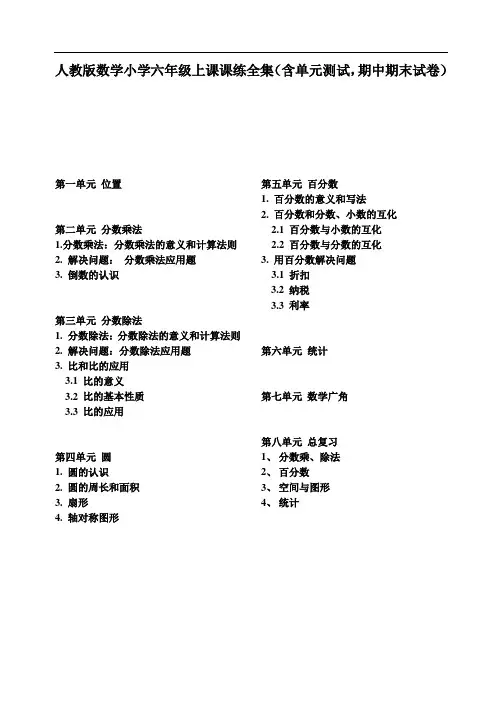
人教版数学小学六年级上课课练全集(含单元测试,期中期末试卷)第一单元位置第二单元分数乘法1.分数乘法:分数乘法的意义和计算法则2. 解决问题:分数乘法应用题3. 倒数的认识第三单元分数除法1. 分数除法:分数除法的意义和计算法则2. 解决问题:分数除法应用题3. 比和比的应用3.1 比的意义3.2 比的基本性质3.3 比的应用第四单元圆1. 圆的认识2. 圆的周长和面积3. 扇形4. 轴对称图形第五单元百分数1. 百分数的意义和写法2. 百分数和分数、小数的互化2.1 百分数与小数的互化2.2 百分数与分数的互化3. 用百分数解决问题3.1 折扣3.2 纳税3.3 利率第六单元统计第七单元数学广角第八单元总复习1、分数乘、除法2、百分数3、空间与图形4、统计第一单元 位置年 班 姓名一、想一想,填一填。
1. 在表示位置时,( )叫做列,( )叫做行。
2. 确定第几列一般是从( )往( )数,确定第几行一般是从( )往( )数。
3. 用数对表示位置时,一般先表示( ),再表示( )。
4. 我坐在教室的第( )列,第( )行。
我在教室的位置用数对表示是( ),我同桌的位置用数对表示是( )。
二、找一找,标一标。
下面是实验小学教师家属楼的平面示意图。
所在列就是楼房的单元,行就是楼房的层数。
(1)如果用(2,5)表示王老师家所在的位置, 实验小学教师家属楼平面示意图则宣老师家在( ),马老师家在( ),张老师家在( )。
(2)你能根据下面的位置说明标出姜老师、 于老师、 胡老师、贺老师家的位置吗? 姜老师(3,3) 于老师(4,6)胡老师(5,4) 贺老师(6,5) 三、涂一涂,想一想。
(3,2)这个小格已经涂好,请你按照这个方法接着涂,看看涂好的图形是 什么?(3,5) (4,2) (3,3) (5,2) (3,4) (6,2) (3,8) (4,5) (4,8) (5,5) (5,8) (6,5) (6,8) (3,6) (3,7) 涂好的图形是( )。
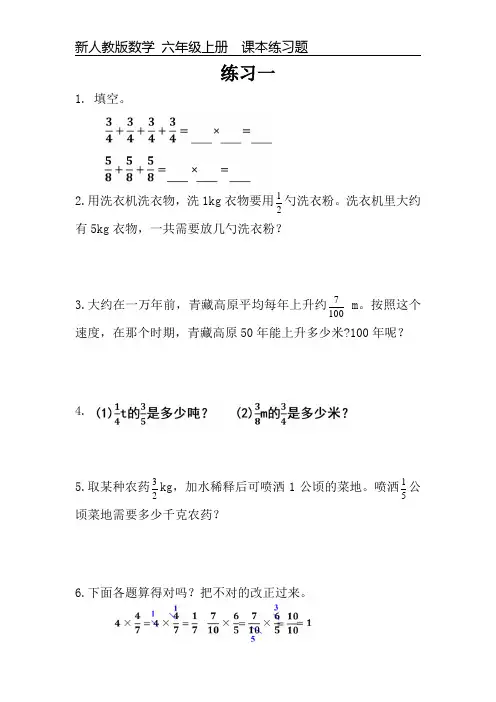
练习一1. 填空。
2.用洗衣机洗衣物,洗1kg 衣物要用21勺洗衣粉。
洗衣机里大约有5kg 衣物,一共需要放几勺洗衣粉?3.大约在一万年前,青藏高原平均每年上升约1007m 。
按照这个速度,在那个时期,青藏高原50年能上升多少米?100年呢? 4.5.取某种农药23kg ,加水稀释后可喷洒1公顷的菜地。
喷洒51公顷菜地需要多少千克农药?6.下面各题算得对吗?把不对的改正过来。
7.计算下面各题。
8.故宫博物院占地总面积约为72万平方米,其中建筑面积占总5。
故宫博物院的建筑面积约为多少万平方米?面积的243。
9.全世界鹤类共有15种,我国的鹤类种数最多,占全世界的5我国有多少种鹤?10. 牛郎星平均运行速度是26千米/秒,织女星平均运行速度是7,织女星平均每秒运行多少千米?牛郎星的1311. 2021年,北京市空气质量为优和良的天数占全年的(365天)288。
2021年北京市有多少天的空气质量为优和良?36512. 再生纸是以废纸为原料加工生产出来的纸张,被誉为低能耗、轻污染的环保型用纸。
回收的废纸可以加工出相当于废纸原4的再生纸。
重的5(1)李阿姨的办公室整理出80kg的废旧报纸、书籍,如果用于制造再生纸,可以制成多少千克的再生纸?(2)据中国造纸协会统计,2021年全国纸及纸板消费量约126502可回收利用,可回收利用的纸和纸板大约有万吨,如果其中有5多少万吨?3。
如果长期背负过重物体,13. 儿童的负重最好不超过体重的20会导致腰痛及背痛,严重的甚至会妨碍骨骼成长。
(1)李明的书包超重吗?为什么?(2)称一称你的体重,算一算你负重最好不要超过多少千克。
练习二1. 计算下面各题。
2.2021年我国人均国内生产总值约为8.1万元。
2020年我国人8。
2020年我国人均国内生产总均国内生产总值约为2021年的9值约为多少万元?3.鸵鸟是目前世界上最大的鸟,一只鸵鸟的身高是2.5 m。
一只12。
这只成年帝企鹅的身高是多少成年的帝企鹅身高是鸵鸟的25米?4.蜂蜜最主要的成分是果糖和葡萄糖,果糖和葡萄糖的质量占蜂3以上。
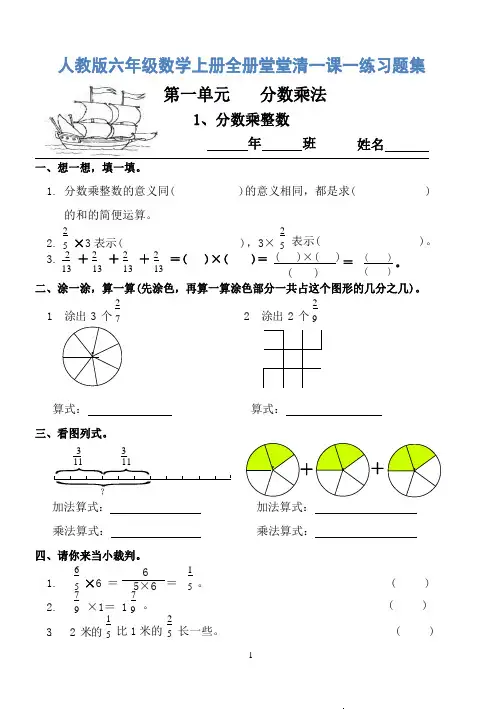
..人教版六年级数学上册全册堂堂清一课一练习题集一、想一想,填一填。
1. 分数乘整数的意义同()的意义相同,都是求()的和的简便运算。
222. 5 ×3 表示( ),3× 5表示( )。
2 2 2 2 3. + + + =( )×( )= ( )×( ) = ( ) 。
13 13 13 13 ( )( ) 二、涂一涂,算一算(先涂色,再算一算涂色部分一共占这个图形的几分之几)。
2 1.涂出 3 个 722.涂出 2 个 9算式:算式:三、看图列式。
3 3 1111++加法算式:加法算式:乘法算式:乘法算式:四、请你来当小裁判。
6 1. 5 ×6 = 765×6 71 = 5 。
( ) 2. 9 ×1= 1 9 1 。
( ) 23.2 米的 5 比1 米的 5 长一些。
().第一单元分数乘法1、分数乘整数年班姓名.5 4.1吨的81和5 吨的8一样重。
( )五、看谁算得又对又快。
3 1 57 ×2=9 5 5 9 ×6=244 ×8=167×36=113×4=×4=721 ×7= 5 ×7=24× 27 =六、走进生活,解决问题。
11.一箱香蕉重20 吨,15 箱这样的香蕉重多少吨?12.小红每分钟走13千米,她 26 分钟能走多少千米?33.一根钢管锯成 2 段需要4分钟,如果锯成 9 段需要多少分钟?24.一台拖拉机每小时耕地7公顷,3 台拖拉机 14 小时耕地多少公顷?七、智力大比拼!3 3 31. 计算。
4 + 4 +……+43=( )×()=( )2000 个42. 看谁算得快。
1 1 1 1 1 12 + 6 +12 +20 +30 +42 你一定是最快的!相信自己!10 2、分数乘分数年 班 姓名一、想一想,填一填。
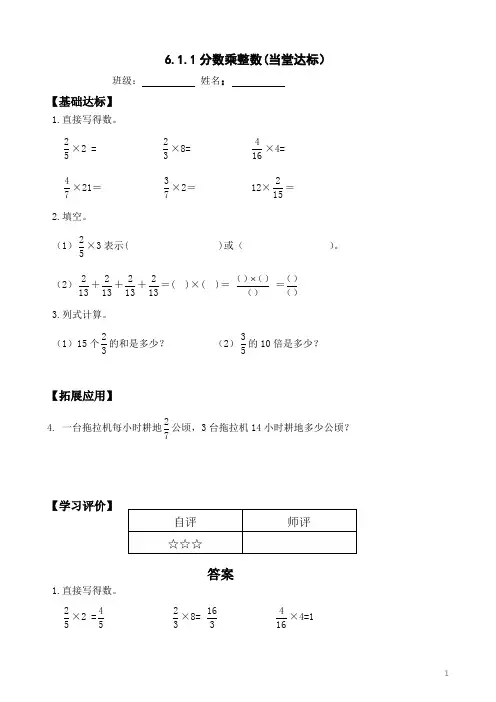
6.1.1分数乘整数(当堂达标)班级: 姓名:【基础达标】1.直接写得数。
52×2 = 32×8= 164×4= 74×21= 73×2= 12×152= 2.填空。
(1)52×3表示( )或( )。
(2)132+132+132+132=( )×( )= ()()() =()() 3.列式计算。
(1)15个32的和是多少? (2)53的10倍是多少?【拓展应用】4. 一台拖拉机每小时耕地72公顷,3台拖拉机14小时耕地多少公顷?【学习评价】答案 1.直接写得数。
52×2 =54 32×8= 316 164×4=174×21=12 73×2=76 12×152=58 2.填空。
(1)52×3表示( 3个 52相加的和是多少 )或(52的3倍是多少 )。
(2)132+132+132+132=( 132)×(4)= )13()4()2( =)13()8( 3.列式计算。
(1)15个32的和是多少? (2)53的10倍是多少?32×15=10 53×10=64. 一台拖拉机每小时耕地72公顷,3台拖拉机14小时耕地多少公顷?72×3×14=12(公顷)6.1.2一个数乘分数的意义(当堂达标)班级: 姓名:【基础达标】1.直接写得数。
65×8 = 56×87= 9×125= 2.填空。
(1)117×3表示( ),3×117表示( )。
(2)一根绳子长12米,3根这样的绳子共长( )米;这根绳子的31长( )米,这根绳子的43长( )米。
3.列式计算。
32个83米有多少米? 8千克的43是多少千克?【拓展应用】4. 一个平行四边形的底25cm ,高是底的53。
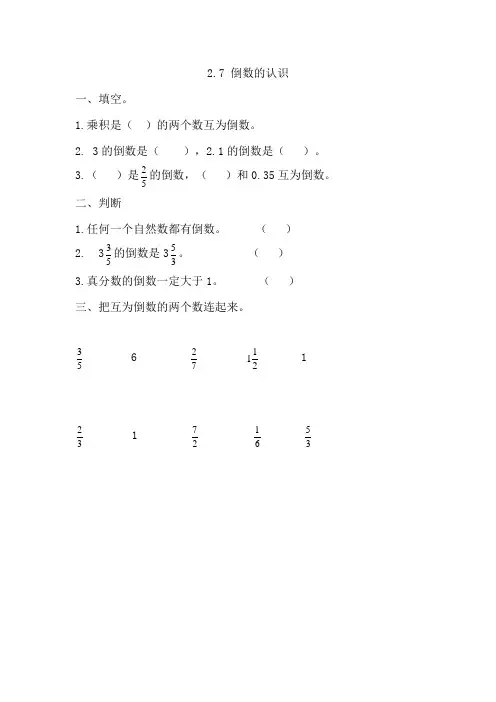
2.7 倒数的认识一、填空。
1.乘积是( )的两个数互为倒数。
2. 3的倒数是( ),2.1的倒数是( )。
3.( )是52的倒数,( )和0.35互为倒数。
二、判断1.任何一个自然数都有倒数。
( )2. 353的倒数是335。
( ) 3.真分数的倒数一定大于1。
( ) 三、把互为倒数的两个数连起来。
53 6 72 211 132 1 27 61 35答案:一、1. 1 2. 31 2110 3. 25 720 二、1. × 2. × 3.√ 三、53 6 72 211 132 1 27 61 352.8 练习六一、计算83×65= 169×34= 127×53×145= 76×43×97= 二、育红小学五年级有48人,四年级的人数是五年级的1211,六年级的人数是四年级的1113,六年级有多少人?三、一个长方体的长是65分米,宽43分米,高52分米,这个长方体的体积是多少立方分米?答案:一、165 43 81 21 二、48×1211×1113=52(人)三、65×43×52=41(立方分米)2.9 整理与练习一、填空。
1. ( )的倒数是1.25, 3与它的倒数相差( )。
2.一根丝带长65米,如果用去21米,还剩( )米;如果用去21,还剩( )米。
二、看图列式计算三、小明拿一根3米的铁丝,剪下它的43用来做玩具,实际只用了剪下的32,他做玩具用了铁丝多少米?答案:一、1. 54232 2. 31125 二、440×113=120(度) 三、3×43×32=23(米)2.9 整理与练习一、填空。
1. ( )的倒数是1.25, 3与它的倒数相差( )。
2.一根丝带长65米,如果用去21米,还剩( )米;如果用去21,还剩( )米。
二、看图列式计算三、小明拿一根3米的铁丝,剪下它的43用来做玩具,实际只用了剪下的32,他做玩具用了铁丝多少米?答案:一、1. 54232 2. 31125 二、440×113=120(度) 三、3×43×32=23(米)。
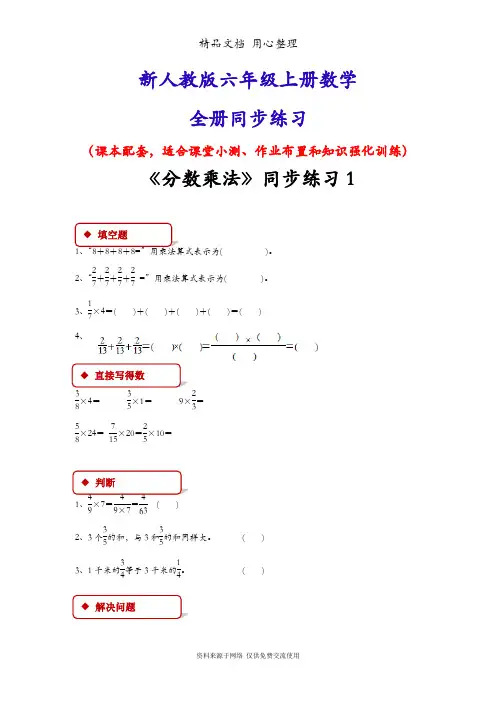
新人教版六年级上册数学全册同步练习(课本配套,适合课堂小测、作业布置和知识强化训练)《分数乘法》同步练习11、“8+8+8+8=”用乘法算式表示为( )。
2、“27+27+27+27 =”用乘法算式表示为( )。
3、17×4=( )+( )+( )+( )=( ) 4、8×4= 5×1= 9×23= 58×24= 715×20=25×10=1、49×7=49×7=463( ) 2、3个35的和,与3和35的和同样大。
( )3、1千米的34等于3千米的14。
( )◆ 判断◆ 直接写得数◆ 填空题◆ 解决问题1、一堆煤,每天用去它的18,3天用去它的几分之几?2、一张长方形铁皮,长是6米,宽是12米,这张铁皮的面积是多少平方米?4、一个漏水的水龙头每小时滴水112桶,3小时滴水多少桶?一天呢?5、小明放学回家,从一楼走到二楼用了38分钟,用同样的速度从一楼走到六楼用多少分钟?《分数乘法》同步练习21、25×100= 2、 18×16 = 3、 16 ×12= 4、 23×6+1=5、 32×3=6、 18×8=1、4 ×8 ×162、1415 +29 ×0.3 1、在○里填上“>”、“<”或“=”。
56 ×4○56 38 ×12 ○382、比1多16 的数是( );比1少34 的数是( )。
1、13×0=2、 14 × 25 =3、 56 ×12=4、9×718 =5、 23 × 910 =6、 425 ×100=1、苹果的32等于梨的52,那么苹果比梨多。
( ) 2、男生人数比女生多51,那么女生人数比男生少51。
( )3、一根彩带长6米,剪去了它的31,还剩532米。
第一单元 位置年 班姓名一、想一想,填一填。
1. 在表示位置时,( )叫做列,( )叫做行。
2. 确定第几列一般是从( )往( )数,确定第几行一般是从( )往( )数。
3. 用数对表示位置时,一般先表示( ),再表示( )。
4. 我坐在教室的第( )列,第( )行。
我在教室的位置用数对表示是( ),我同桌的位置用数对表示是( )。
二、找一找,标一标。
下面是实验小学教师家属楼的平面示意图。
所在列就是楼房的单元,行就是楼房的层数。
(1)如果用(2,5)表示王老师家所在的位置, 实验小学教师家属楼平面示意图则宣老师家在( ),马老师家在( ),张老师家在( )。
(2)你能根据下面的位置说明标出姜老师、 于老师、 胡老师、贺老师家的位置吗? 姜老师(3,3) 于老师(4,6)胡老师(5,4) 贺老师(6,5) 三、涂一涂,想一想。
(3,2)这个小格已经涂好,请你按照这个方法接着涂,看看涂好的图形是 什么?(3,5) (4,2) (3,3) (5,2) (3,4) (6,2) (3,8) (4,5) (4,8) (5,5) (5,8) (6,5) (6,8) (3,6) (3,7) 涂好的图形是( )。
4321马老师张老师王老师宣老师76512四、填一填,画一画。
1. 写出平行四边形各顶点的位置。
2. 分别画出向左平移4个单位和向上 平移4个单位后的图形。
3. 写出所得图形顶点的位置。
(1)向左平移4个单位后的图形: A 1 ( ) B 1 ( ) C 1( ) D 1( ) (2)向上平移4个单位后的图形:A 2 ( )B 2( )C 2( )D 2( ) 五、游览动植物园。
小红(1)你能像小红那样描述一下虎山的位 置吗? (2)牡丹园在猴山以北150m,再往西100m处,你能在图中标出牡丹园的位置吗?标好位置后再填一填。
牡丹园( , ) (3)小红去动植物园玩,她先到猴山,然后去熊猫馆,再到孔雀馆,又去了虎山,最后到了水族馆。
1.1分数乘整数一、填一填。
1.74+74+74=( )×( ) 2. 107×2=( )+( ) 3.94×5表示( )。
4.8个111的和是( );求6个92的和,列式是( )。
5.一个正方形的边长是152米,它的周长是( )米。
二、计算。
113×2= 169×5= 4×157= 93×5= 7×107=三、一个漏水的水龙头每小时滴水101桶,5小时滴水多少桶?10小时呢?24小时呢?四、教室的门高2米,小明的身高大约是门高的43,小明的身高是多少米?五、爸爸和红红都感冒了,妈妈要给他们买3天的药。
1.红红和爸爸一天分别要吃多少袋?2.妈妈需要买多少袋药?答案:一、 1. 47 3 2. 710 710 3. 5个49 相加 4.8116×295.815二、 611 4516 2815 53 4910 三、110×5=12(桶)110×10=1(桶)110×24=125(桶)四、2×34=32(米)五、 1. 13×3=1(袋) 12×3=32(袋)2. 1×3+32×3=712(袋)1.2分数乘分数一、计算。
3241⨯= 31×61= 4131⨯= 3152⨯=14587⨯= 9843⨯= 7921⨯= 7683⨯= 6792⨯= 56245⨯= 二、列式计算。
1.71的51是多少?2.43的65是多少? 3.156千克的31是多少千克? 4.87米的214是多少米?三、校园面积的53是空地,空地的32准备铺草坪,铺草坪的面积占校园总面积的几分之几?四、五(1)班和五(2)班同学在学校操场上打扫卫生,每班负责打扫操场的一半。
五(1)班完成了本班任务的53,五(2)班完成了本班任务的54。
两个班分别打扫了操场的几分之几?答案:一、1611811221551623914928727 14二、1. 17×15=1352. 34×56=583.615×13=2154. 78×421=16三、35×23=25四、12× 35=31012× 45=251.3 整数乘法运算定律推广到分数一、用简便方法计算。
6.1.1 分数乘整数(学案)一、知识铺垫1.你能说出下面算式的意义吗?12×4 25×6 53×8想一想:整数乘法的意义是什么?2.看图填空。
(细心观察,认真思考,仔细推理并发现其中的规律性。
)(1)()+ ()+ ()= ()×()=()(2)()+ ()+ ()+()= ()×()=()想一想:(1)以上两个加法算式的特点是()。
(2)几个相同()数的和,可以改写成()算式。
二、自主探究1.自学课本2页的例1,通过多种方式想一想分数乘整数的意义是什么?2.分数乘整数的意义:(写在下面)3.想一想、试一试,你能用几种方法计算?(学习提示:转化和迁移的学习方法)4.看课本补充算法。
5.讨论:以上几种方法,你认为哪种算法比较简便?平时计算时你会选择哪种方法计算?6、小结:分数乘整数的计算方法:(写在下面)三、达标练习1.填空(1)415×4 表示()或表示()(2)4个15的和是多少?用乘法计算可列式为( )。
2.计算121×4= 59 ×3= 8 ×518 =3.列式计算(1)6个718 相加的和是多少? (2)37的5倍是多少?4.解决问题一辆汽车每分钟行65千米,这辆汽车每小时行驶多少千米?四、拓展练习一根钢管锯成2段需要43分钟,如果锯成9段需要多少分钟?达标测试答案 1.填空(1)415×4 表示(4个415 相加的和是多少)或表示(415的4倍是多少)。
(2)4个15 的和是多少?用乘法计算可列式为(15 ×4=54 )。
2.计算121×4=31 59 ×3=35 8 ×518 = 9203.列式计算(1)6个718 相加的和是多少? (2)37的5倍是多少?718 ×6=3737 ×5=715 4.解决问题一辆汽车每分钟行65千米,这辆汽车每小时行驶多少千米?65×60=72(千米)四、拓展练习 一根钢管锯成2段需要43分钟,如果锯成9段需要多少分钟? 43×(9-1)=43×8=6(分钟)6.1.2 一个数乘分数的意义(学案) 班级 姓名【学习目标】1.结合具体的情境理解一个数乘分数的意义。
人教版六年级上册数学全册课堂练习题1、分数乘法应用题练习一【知识要点】求一个数的几分之几是多少和求一个数的几倍是多少的分数应用题的解题思路和解答方法。
【课内检测】1、一本书100页,看了14,看了多少页?想:看了14,是看了的14,就是把看作单位“1”,求看了多少页,就是求的是多少?2、小刚每分钟行50米,小李每分钟行的是小刚的45,小李每分钟行多少米?想:根据“小李每分钟行的是小刚的45,把看作单位“1”,求小李每分钟行多少米,就是求的是多少?3、饲养小组养了60只白兔。
①黑兔的只数是白兔的25,黑兔有多少只?②灰兔的只数是白兔的54倍,灰兔有多少只?【课外训练】★1、一篮桃子共48个,小猴子吃掉了篮桃子的一半少5个,大猴子吃掉这篮桃子的13多5个,哪只猴子吃的多?计算说明★2、甲、乙两站相距720千米,一列火车从甲站开往乙站,已经行了全程的58,这时火车超过两站中点多少千米?★★3、两根同样长的绳子,第一根剪掉了12米,第二根剪掉了12,哪一根剪下的多?为什么?练习二【知识要点】分数乘法应用题的解题思路和解答方法【课内检测】1、用“~~~”画出各题中单位“1”的量,再把关系补充完整。
①母鸡的只数比公鸡的只数多14。
( )×( )=( )②彩电现价比原价降低了110。
( )×( )=( )2、李大伯家养鸡60只,养的鸭比鸡少16,鸭比鸡少多少只?想:根据“养的鸭比鸡少16”。
把看作单位“1”,求鸭比鸡少多少只,就是求的是多少。
3、应用题。
①一件上衣原价是280元,现价比原价降低了37,降低了多少元?②去年小王家收入28000元,今年比去年增加了17,今年比去年多收入多少元?【课外训练】1、有20个桃子,小俊第一天吃掉了一些后,还剩15,还剩多少个?小俊第一天吃掉多少个?★2、儿童乐园的碰碰车项目,原来每玩10分钟收5元,六一儿童节那天调整了价格,降低了1 5 ,这样每玩10分钟碰碰车,比原来可以少付多少元?★3、小区里栽水杉400棵,栽的梧桐比水杉多14,栽了梧桐多少棵?★★4、小明倒了杯牛奶,先喝了12,接着加满咖啡,又喝了这杯的13,再加满,最后把这杯牛奶全部喝完,那么小明喝的牛奶多还是咖啡多?练习三【知识要点】求一个数的几分之几是多少的连乘应用题的数量和解题方法。
1、 人教版六年级数学上册课堂练习2、分数乘法应用题练习一【知识要点】求一个数的几分之几是多少和求一个数的几倍是多少的分数应用题的解题思路和解答方法。
【课内检测】1、一本书100页,看了14,看了多少页?想:看了14 ,是看了 的14,就是把 看作单位“1”,求看了多少页,就是求 的 是多少?2、小刚每分钟行50米,小李每分钟行的是小刚的45,小李每分钟行多少米?想:根据“小李每分钟行的是小刚的45,把 看作单位“1”,求小李每分钟行多少米,就是求 的 是多少?3、饲养小组养了60只白兔。
①黑兔的只数是白兔的25 ,黑兔有多少只? ②灰兔的只数是白兔的54倍,灰兔有多少只?【课外训练】★1、一篮桃子共48个,小猴子吃掉了篮桃子的一半少5个,大猴子吃掉这篮桃子的13多5个,哪只猴子吃的多?计算说明★2、甲、乙两站相距720千米,一列火车从甲站开往乙站,已经行了全程的58,这时火车超过两站中点多少千米?★★3、两根同样长的绳子,第一根剪掉了12 米,第二根剪掉了12,哪一根剪下的多?为什么?练习二【知识要点】分数乘法应用题的解题思路和解答方法【课内检测】1、用“~~~”画出各题中单位“1”的量,再把关系补充完整。
①母鸡的只数比公鸡的只数多14。
( )×( )=( )②彩电现价比原价降低了110。
( )×( )=( )2、李大伯家养鸡60只,养的鸭比鸡少16,鸭比鸡少多少只?想:根据“养的鸭比鸡少16”。
把看作单位“1”,求鸭比鸡少多少只,就是求的是多少。
3、应用题。
①一件上衣原价是280元,现价比原价降低了37,降低了多少元?②去年小王家收入28000元,今年比去年增加了17,今年比去年多收入多少元?【课外训练】1、有20个桃子,小俊第一天吃掉了一些后,还剩15,还剩多少个?小俊第一天吃掉多少个?★2、儿童乐园的碰碰车项目,原来每玩10分钟收5元,六一儿童节那天调整了价格,降低了15,这样每玩10分钟碰碰车,比原来可以少付多少元?★3、小区里栽水杉400棵,栽的梧桐比水杉多14,栽了梧桐多少棵?★★4、小明倒了杯牛奶,先喝了12,接着加满咖啡,又喝了这杯的13,再加满,最后把这杯牛奶全部喝完,那么小明喝的牛奶多还是咖啡多?练习三【知识要点】求一个数的几分之几是多少的连乘应用题的数量和解题方法。
人教版六年级数学上册课堂练习2、分数乘法应用题练习一【知识要点】求一个数的几分之几是多少和求一个数的几倍是多少的分数应用题的解题思路和解答方法。
【课内检测】1、一本书100页,看了14,看了多少页?想:看了14,是看了的14,就是把看作单位“1”,求看了多少页,就是求的是多少?2、小刚每分钟行50米,小李每分钟行的是小刚的45,小李每分钟行多少米?想:根据“小李每分钟行的是小刚的45,把看作单位“1”,求小李每分钟行多少米,就是求的是多少?3、饲养小组养了60只白兔。
①黑兔的只数是白兔的25,黑兔有多少只?②灰兔的只数是白兔的54倍,灰兔有多少只?【课外训练】★1、一篮桃子共48个,小猴子吃掉了篮桃子的一半少5个,大猴子吃掉这篮桃子的13多5个,哪只猴子吃的多?计算说明★2、甲、乙两站相距720千米,一列火车从甲站开往乙站,已经行了全程的58,这时火车超过两站中点多少千米?★★3、两根同样长的绳子,第一根剪掉了12米,第二根剪掉了12,哪一根剪下的多?为什么?练习二【知识要点】分数乘法应用题的解题思路和解答方法【课内检测】1、用“~~~”画出各题中单位“1”的量,再把关系补充完整。
①母鸡的只数比公鸡的只数多14。
( )×( )=( )②彩电现价比原价降低了110。
( )×( )=( )2、李大伯家养鸡60只,养的鸭比鸡少16,鸭比鸡少多少只?想:根据“养的鸭比鸡少16”。
把看作单位“1”,求鸭比鸡少多少只,就是求的是多少。
3、应用题。
①一件上衣原价是280元,现价比原价降低了37,降低了多少元?②去年小王家收入28000元,今年比去年增加了17,今年比去年多收入多少元?【课外训练】1、有20个桃子,小俊第一天吃掉了一些后,还剩15,还剩多少个?小俊第一天吃掉多少个?★2、儿童乐园的碰碰车项目,原来每玩10分钟收5元,六一儿童节那天调整了价格,降低了15,这样每玩10分钟碰碰车,比原来可以少付多少元?★3、小区里栽水杉400棵,栽的梧桐比水杉多14,栽了梧桐多少棵?★★4、小明倒了杯牛奶,先喝了12,接着加满咖啡,又喝了这杯的13,再加满,最后把这杯牛奶全部喝完,那么小明喝的牛奶多还是咖啡多?练习三【知识要点】求一个数的几分之几是多少的连乘应用题的数量和解题方法。